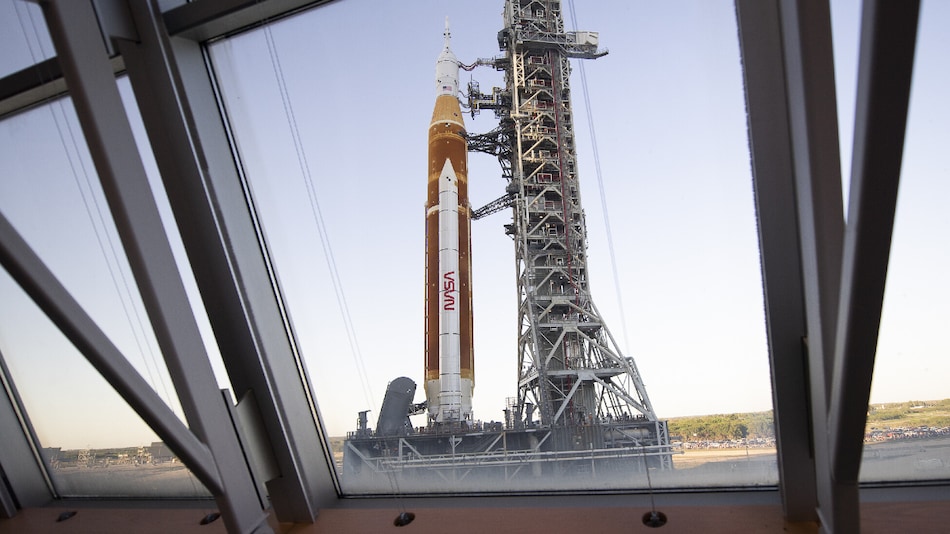- Home
- Science
- Science News
- NASA's 'Lunar IceCube' Moon Observing CubeSat Ready for Artemis Launch
NASA's 'Lunar IceCube' Moon-Observing CubeSat Ready for Artemis Launch
Lunar IceCube, one of the first tiny satellites to explore deep space, is expected to set the groundwork for future small-scale planetary missions.

Photo Credit: Twitter/NASA Hubble
In May, NASA announced possible launch dates for the Artemis I unmanned mission in H2 2022
NASA's water-scouting CubeSat is all set to make its way to lunar orbit. Information from the shoebox sized Lunar IceCube will have a significant impact on lunar science. As part of the unmanned Artemis I mission, which is expected to launch this year, the satellite has been fitted onto the Space Launch System (SLS) rocket and is prepared to travel to the Moon. Lunar IceCube will orbit the Moon and use a spectrometer to investigate lunar ice. Lunar IceCube will enhance the space agency's understanding of lunar ice dynamics despite earlier missions having found water ice on the Moon.
It is now more crucial than ever to find water on the lunar surface and understand its nature. Water ice is the predominant form of lunar water, yet it is not the only one. This ice might be used by astronauts on the Moon for a variety of crew needs — even rocket fuel.
Watch this video by NASA on the Lunar IceCube's mission:
The stony and dusty regolith surface of the Moon is of interest to scientists because it can absorb and release water. NASA can map these changes as they take place on the Moon, thanks to Lunar IceCube's investigation of this process.
The exosphere, or volume that resembles a very thin atmosphere and surrounds the Moon, will also be studied by Lunar IceCube. Scientists will be able to forecast seasonal variations for lunar ice that could have an impact on its utilisation as a resource in the future by understanding the dynamics of water and other chemicals on the Moon.
All of this will be possible with a 31-pound (roughly 14 kg) CubeSat that is efficient and economical. One of the CubeSats being transported to the Moon by Artemis I is Lunar IceCube. The US space agency says that future Artemis missions and these tiny satellites will advance our understanding of how to live and work on the Moon and, eventually, Mars.
A NASA blogpost had stated that the Lunar IceCube mission was selected as one of several public-private collaborations for the development of cutting-edge exploration systems. The purpose of Lunar IceCube, one of the first tiny satellites to explore deep space, was to set the groundwork for future small-scale planetary missions.
Catch the latest from the Consumer Electronics Show on Gadgets 360, at our CES 2026 hub.
Related Stories
- Samsung Galaxy Unpacked 2025
- ChatGPT
- Redmi Note 14 Pro+
- iPhone 16
- Apple Vision Pro
- Oneplus 12
- OnePlus Nord CE 3 Lite 5G
- iPhone 13
- Xiaomi 14 Pro
- Oppo Find N3
- Tecno Spark Go (2023)
- Realme V30
- Best Phones Under 25000
- Samsung Galaxy S24 Series
- Cryptocurrency
- iQoo 12
- Samsung Galaxy S24 Ultra
- Giottus
- Samsung Galaxy Z Flip 5
- Apple 'Scary Fast'
- Housefull 5
- GoPro Hero 12 Black Review
- Invincible Season 2
- JioGlass
- HD Ready TV
- Laptop Under 50000
- Smartwatch Under 10000
- Latest Mobile Phones
- Compare Phones
- OPPO Reno 15 Pro Max
- Honor Win RT
- Honor Win
- Xiaomi 17 Ultra Leica Edition
- Xiaomi 17 Ultra
- Huawei Nova 15
- Huawei Nova 15 Pro
- Huawei Nova 15 Ultra
- Asus ProArt P16
- MacBook Pro 14-inch (M5, 2025)
- OPPO Pad Air 5
- Huawei MatePad 11.5 (2026)
- Xiaomi Watch 5
- Huawei Watch 10th Anniversary Edition
- Acerpure Nitro Z Series 100-inch QLED TV
- Samsung 43 Inch LED Ultra HD (4K) Smart TV (UA43UE81AFULXL)
- Asus ROG Ally
- Nintendo Switch Lite
- Haier 1.6 Ton 5 Star Inverter Split AC (HSU19G-MZAID5BN-INV)
- Haier 1.6 Ton 5 Star Inverter Split AC (HSU19G-MZAIM5BN-INV)

















